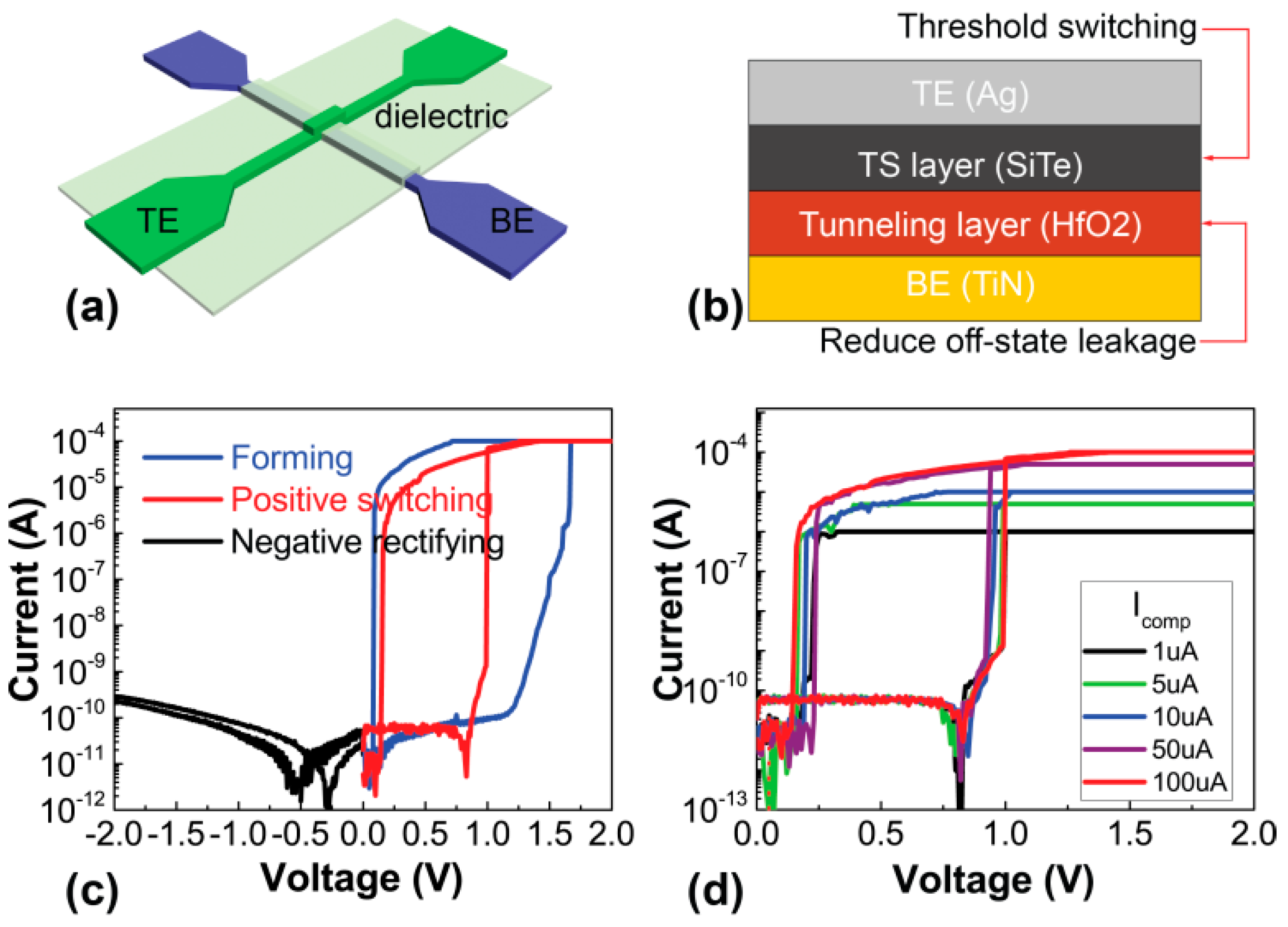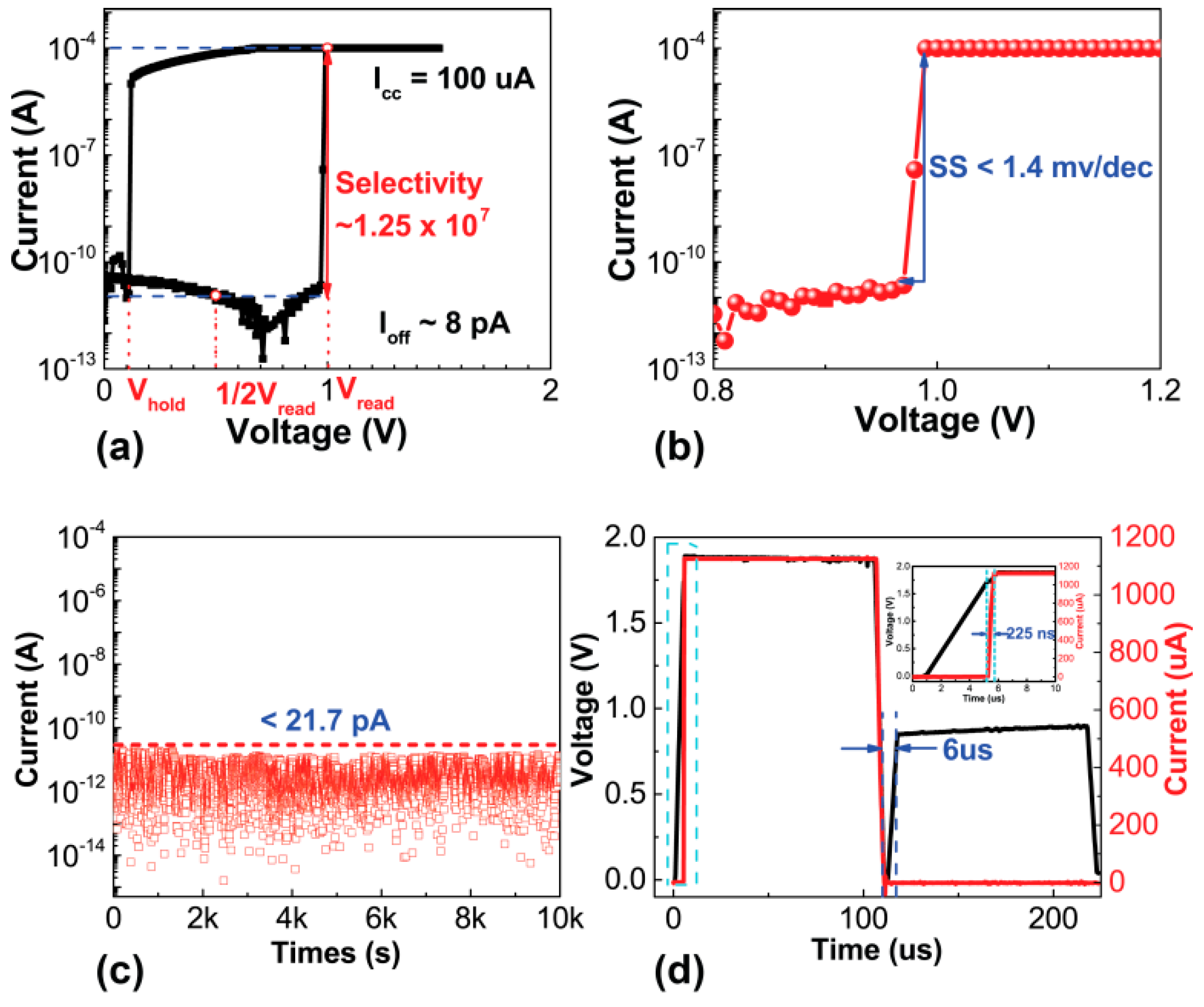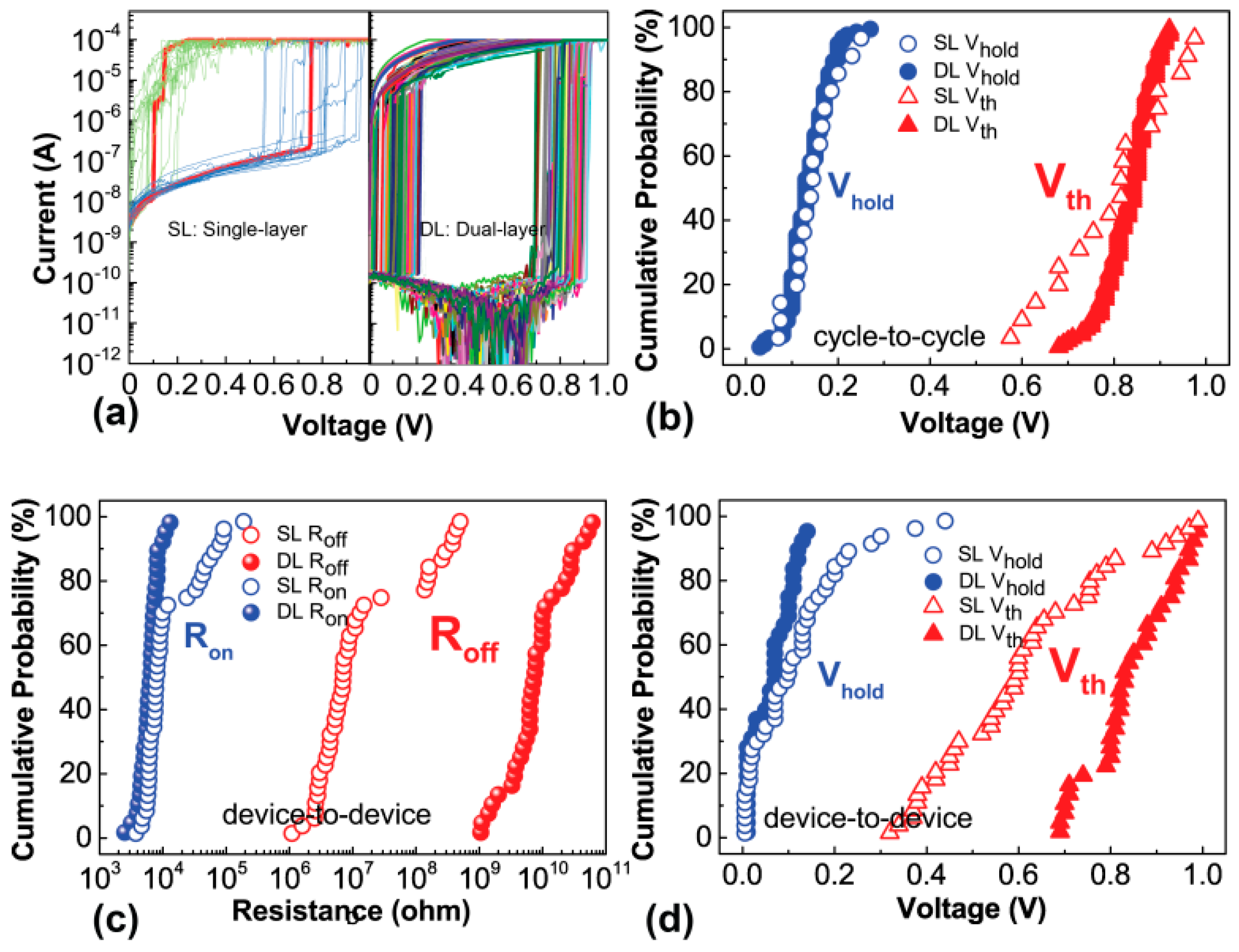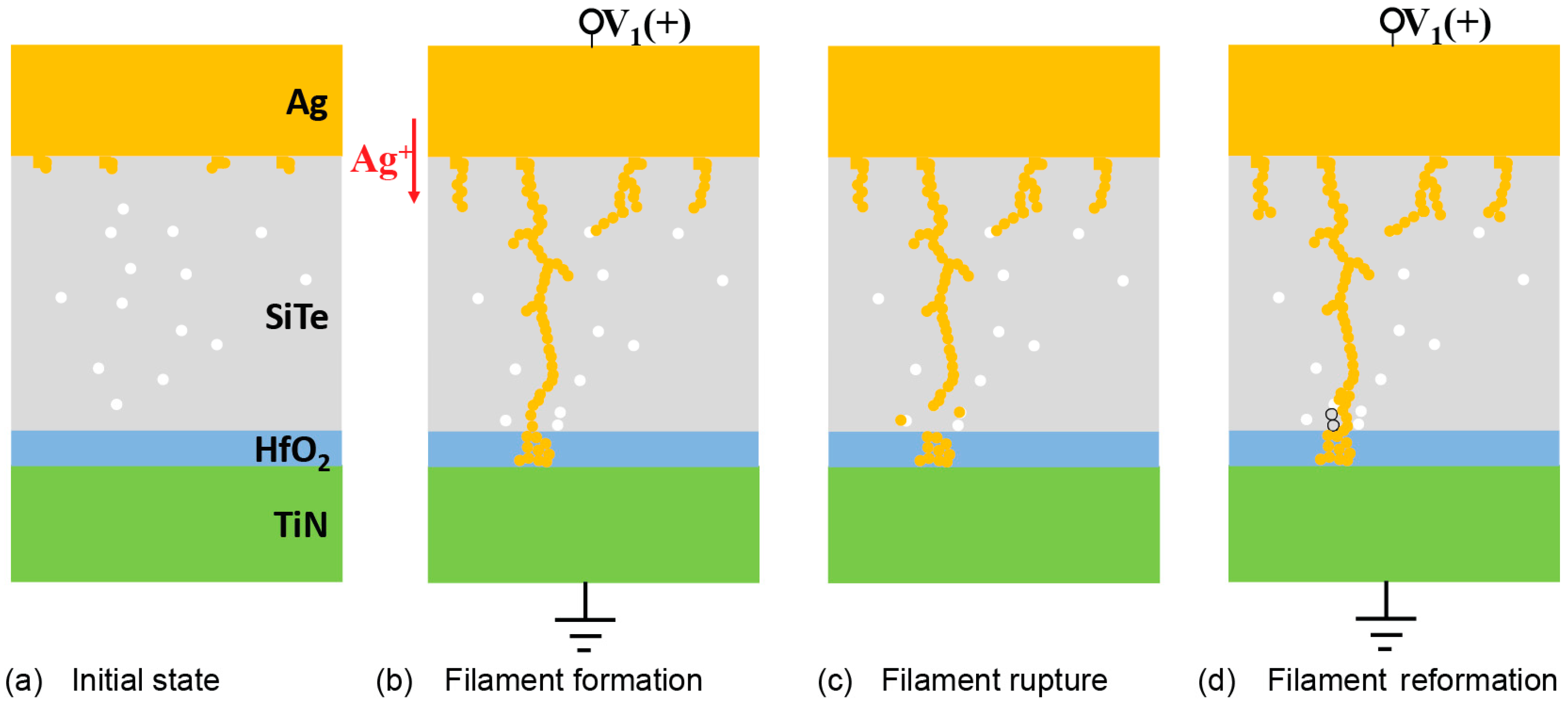A HfO2/SiTe Based Dual-Layer Selector Device with Minor Threshold Voltage Variation
Abstract
1. Introduction
2. Materials and Methods
3. Results
4. Conclusions
Author Contributions
Funding
Conflicts of Interest
References
- Zidan, M.A.; Strachan, J.P.; Lu, W.D. The future of electronics based on memristive systems. Nat. Electron. 2018, 1, 22–29. [Google Scholar] [CrossRef]
- Zaffora, A.; Cho, D.Y.; Lee, K.S.; Quarto, F.D.; Waser, R.; Santamaria, M.; Valov, I. Electrochemical Tantalum Oxide for Resistive Switching Memories. Adv. Mater. 2017, 29, 1703357. [Google Scholar] [CrossRef] [PubMed]
- Mao, M.; Yu, S.; Chakrabarti, C. Design and Analysis of Energy-Efficient and Reliable 3-D ReRAM Cross-Point Array System. IEEE Trans. VLSI Syst. 2018, 26, 1290–1300. [Google Scholar] [CrossRef]
- Burr, G.W.; Shelby, R.M.; Sebastian, A.; Kim, S.; Kim, S.; Sidler, S. Neuromorphic computing using non-volatile memory. Adv. Phys. X 2017, 2, 89–124. [Google Scholar] [CrossRef]
- Choi, S.; Tan, S.H.; Li, Z.; Kim, Y.; Choi, C.; Chen, P.Y.; Yeon, H.; Yu, S.; Kim, J. SiGe epitaxial memory for neuromorphic computing with reproducible high performance based on engineered dislocations. Nat. Mater. 2018, 17, 1–7. [Google Scholar] [CrossRef] [PubMed]
- Ielmini, D.; Wong, H.S.P. In-memory computing with resistive switching devices. Nat. Electron. 2018, 1, 333–343. [Google Scholar] [CrossRef]
- Chi, P.; Li, S.; Xu, C.; Zhang, T.; Zhao, J.; Liu, Y.; Wang, Y.; Xie, Y. PRIME: A Novel Processing-in-Memory Architecture for Neural Network Computation in ReRAM-Based Main Memory. In Proceedings of the 2016 ACM/IEEE 43rd Annual International Symposium on Computer Architecture (ISCA), Seoul, Korea, 18–22 June 2016; pp. 27–39. [Google Scholar]
- Burr, G.W.; Shenoy, R.S.; Virwani, K.; Narayanan, P.; Padilla, A.; Kurdi, B.; Hwang, H. Access devices for 3D crosspoint memory. J. Vac. Sci. Technol. B 2014, 32, 040802. [Google Scholar] [CrossRef]
- Song, B.; Xu, H.; Liu, H.; Li, Q. Impact of threshold voltage variation on 1S1R crossbar array with threshold switching selectors. Appl. Phys. A-Mater. 2017, 123, 356. [Google Scholar] [CrossRef]
- Zhao, X.; Ma, J.; Xiao, X.; Liu, Q.; Shao, L.; Chen, D.; Liu, S.; Niu, J.; Zhang, X.; Wang, Y.; et al. Breaking the Current-Retention Dilemma in Cation-Based Resistive Switching Devices Utilizing Graphene with Controlled Defects. Adv. Mater. 2018, 30, 1705193. [Google Scholar] [CrossRef] [PubMed]
- Yoo, J.; Park, J.; Song, J.; Lim, S.; Hwang, H. Field-induced nucleation in threshold switching characteristics of electrochemical metallization devices. Appl. Phys. Lett. 2018, 111, 063109. [Google Scholar] [CrossRef]
- Lee, T.H.; Kang, D.Y.; Kim, T.G. Ag:SiOxNy-Based Bilayer ReRAM Structure with Self-Limiting Bidirectional Threshold Switching Characteristics for Cross-Point Array Application. Appl. Phys. Lett. ACS Appl. Mater. Interface 2018, 10, 33768–33772. [Google Scholar] [CrossRef] [PubMed]
- Chen, A.; Lin, M.R. Variability of resistive switching memories and its impact on crossbar array performance. In Proceedings of the 2011 IEEE International Reliability Physics Symposium, Monterey, CA, USA, 10–14 April 2011; pp. MY.7.1–MY.7.4. [Google Scholar]
- Zhang, L.; Cosemans, S.; Wouters, D.J.; Groeseneken, G.; Jurczak, M.; Govoreanu, B. Cell Variability Impact on the One-Selector One-Resistor Cross-Point Array Performance. IEEE Trans. Electron Dev. 2015, 62, 3490–3497. [Google Scholar] [CrossRef]
- Song, B.; Xu, H.; Liu, S.; Liu, H.; Li, Q. Threshold Switching Behavior of Ag-SiTe-Based Selector Device and Annealing Effect on its Characteristics. IEEE J. Electron Devi. 2018, 6, 674–679. [Google Scholar] [CrossRef]
- Kumar, D.; Aluguri, R.; Tsenga, U.C.Y. Enhancement of resistive switching properties in nitride based CBRAM device by inserting an Al2O3 thin layer. Appl. Phys. Lett. 2017, 110, 1–9. [Google Scholar] [CrossRef]
- Kumar, D.; Aluguri, R.; Tsenga, U.C.Y. Role of Al2O3 thin layer on improving the resistive switching properties of Ta5Si3-based conductive bridge random accesses memory device. Jpn. J. Appl. Phys. 2018, 57, 04FE16. [Google Scholar] [CrossRef]
- Lv, H.; Wan, H.; Tang, T. Improvement of Resistive Switching Uniformity by Introducing a Thin GST Interface Layer. IEEE Electron Dev. Lett. 2010, 31, 978–981. [Google Scholar] [CrossRef]
- Kim, D.C.; Seo, S.; Ahn, S.E.; Suh, D.-S.; Lee, M.J.; Park, B.-H.; Yoo, I.K.; Baek, I.G.; Kim, H.-J.; Yim, E.K.; et al. Improvement of resistive memory switching in NiO using IrO2. Appl. Phys. Lett. 2006, 88, 232106. [Google Scholar]
- Ogimoto, Y.; Tamai, Y.; Kawasaki, M.; Tokura, Y. Resistance switching memory device with a nanoscale confined current path. Appl. Phys. Lett. 2007, 90, 143515. [Google Scholar] [CrossRef]
- Lim, S.; Yoo, J.; Song, J.; Woo, J.; Park, J.; Hwang, H. Excellent threshold switching device (IOFF ~1 pA) with atom-scale metal filament for steep slope (<5 mV/dec), ultra-low voltage (VDD = 0.25 V) FET applications. In Proceedings of the 2016 IEEE International Electron Devices Meeting (IEDM), San Francisco, CA, USA, 3–7 December 2016; pp. 34.7.1–34.7.4. [Google Scholar]
- Shukla, N.; Grisafe, B.; Ghosh, R.K.; Jao, N.; Aziz, A.; Frougier, J.; Jerry, M.; Sonde, S.; Rouvimov, S.; Orlova, T.; et al. Ag/HfO2 based Threshold Switch with Extreme Non-Linearity for Unipolar Cross-Point Memory and Steep-slope Phase-FETs. In Proceedings of the 2016 IEEE International Electron Devices Meeting (IEDM), San Francisco, CA, USA, 3–7 December 2016; pp. 34.6.1–34.6.4. [Google Scholar]
- Luo, Q.; Xu, X.; Liu, H.; Lv, H.; Gong, T.; Long, S.; Liu, Q.; Sun, H.; Banerjee, W.; Li, L.; et al. Cu BEOL Compatible Selector with High Selectivity Extremely Low Off-current and High Endurance. In Proceedings of the 2015 IEEE International Electron Devices Meeting (IEDM), Washington, DC, USA, 7–9 December 2015; pp. 10.4.1–10.4.4. [Google Scholar]
- Salaoru, I.; Khiat, A.; Li, Q.; Berdan, R.; Papavassiliou, C.; Prodromakis, T. Origin of the OFF state variability in ReRAM cells. J. Phys. D. Appl. Phys. 2014, 47, 145102. [Google Scholar] [CrossRef]
- Park, G.; Li, X.; Kim, D.; Jung, R.; Lee, M.; Seo, S. Observation of electric-field induced Ni filament channels in polycrystalline NiOx film. Appl. Phys. Lett. 2007, 91, 222103. [Google Scholar] [CrossRef]
- Yang, Y.; Gao, P.; Li, L.; Pan, X.; Tappertzhofen, S.; Choi, S.H.; Waser, R.; Valov, I.; Lu, W.D. Electrochemical dynamics of nanoscale metallic inclusions in dielectrics. Nat. Commun. 2014, 5, 5232. [Google Scholar] [CrossRef] [PubMed]
- Celano, U.; Giammaria, G.; Belmonte, A.; Jurczak, M.; Vandervorst, W. Nanoscopic structural rearrangements of the Cu-filament in conductive-bridge memories. Nanoscale 2016, 8, 13915–13923. [Google Scholar] [CrossRef] [PubMed]
- Celano, U.; Goux, L.; Belmonte, A.; Opsomer, K.; Franquet, A.; Schulze, A.; Detavernier, C.; Richard, O.; Bender, H.; Jurczak, M.; et al. Three-Dimensional Observation of the Conductive Filament in Nanoscaled Resistive Memory Devices. Nano Lett. 2014, 14, 2401–2406. [Google Scholar] [CrossRef] [PubMed]
- Lv, H.B.; Yin, M.; Zhou, P.; Tang, T.A.; Chen, B.A.; Bao, A.; Chi, M.H.; Lin, Y.Y. Improvement of endurance and switching stability of forming-free CuxO RRAM. In Proceedings of the 23nd IEEE NVSMW, ICMTD, Opio, France, 18–22 May 2008; pp. 52–53. [Google Scholar]
- Sonde, S.; Chakrabarti, B.; Liu, Y.; Sasikumar, K.; Lin, J.; Stan, L.; Divan, R.; Ocola, L.E.; Rosenmann, D.; Choudhury, P.; et al. Silicon compatible Sn-based resistive switching memory. Nanoscale 2018, 10, 9441–9449. [Google Scholar] [CrossRef] [PubMed]




© 2019 by the authors. Licensee MDPI, Basel, Switzerland. This article is an open access article distributed under the terms and conditions of the Creative Commons Attribution (CC BY) license (http://creativecommons.org/licenses/by/4.0/).
Share and Cite
Song, B.; Cao, R.; Xu, H.; Liu, S.; Liu, H.; Li, Q. A HfO2/SiTe Based Dual-Layer Selector Device with Minor Threshold Voltage Variation. Nanomaterials 2019, 9, 408. https://doi.org/10.3390/nano9030408
Song B, Cao R, Xu H, Liu S, Liu H, Li Q. A HfO2/SiTe Based Dual-Layer Selector Device with Minor Threshold Voltage Variation. Nanomaterials. 2019; 9(3):408. https://doi.org/10.3390/nano9030408
Chicago/Turabian StyleSong, Bing, Rongrong Cao, Hui Xu, Sen Liu, Haijun Liu, and Qingjiang Li. 2019. "A HfO2/SiTe Based Dual-Layer Selector Device with Minor Threshold Voltage Variation" Nanomaterials 9, no. 3: 408. https://doi.org/10.3390/nano9030408
APA StyleSong, B., Cao, R., Xu, H., Liu, S., Liu, H., & Li, Q. (2019). A HfO2/SiTe Based Dual-Layer Selector Device with Minor Threshold Voltage Variation. Nanomaterials, 9(3), 408. https://doi.org/10.3390/nano9030408



